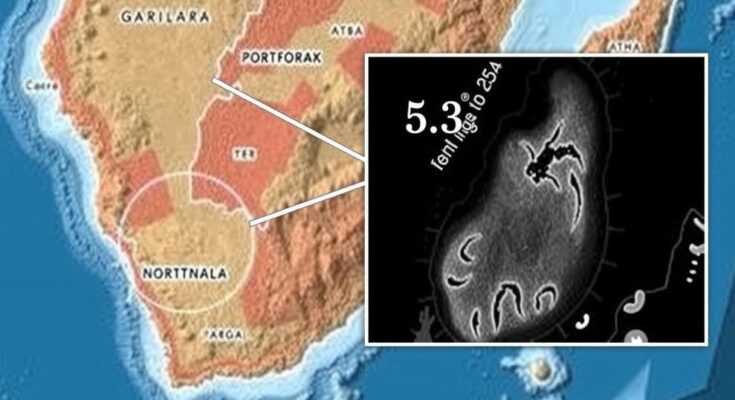A 5.3 magnitude earthquake struck the Northern Cape of South Africa on December 22, 2024, affecting residents over a wide area. The quake prompted fear and raised questions about the region’s susceptibility to seismic activity, leading to discussions on preparedness and monitoring of aftershocks, while historical seismic calm in the area highlighted the event’s unusual nature.
On December 22, 2024, a 5.3 magnitude earthquake struck South Africa’s Northern Cape at 2:51 AM local time, approximately 101 kilometers west of the town of Brandvlei. The seismic event was recorded at a depth of ten kilometers and confirmed by the U.S. Geological Survey as well as the South African Council for Geoscience (CGS). The quake reverberated across large areas, with residents, including those from Cape Town, located about 400 kilometers away, experiencing noticeable tremors.
Local farmers, including Drienie Visser and Lettie Malan, vividly recalled their experiences during the shock. Dr. Visser described her home shaking violently, expressing it was the most intense earthquake they had ever felt, while Ms. Malan stated, “It was quite dramatic and was actually the worst one we have felt over here, I think because we are quite close to the epicenter.” Following the main event, the CGS confirmed several aftershocks occurred, with the most significant reaching a magnitude of 2.9.
Professor Raymond Durrheim of the University of the Witwatersrand noted the region’s history of seismic activity characterized by clusters and swarms of earthquakes. The CGS recorded ten aftershocks in the twelve hours following the initial quake, reflecting increased seismic instability. Though no immediate reports of injuries or serious property damage emerged, spokesperson Mahlatse Mononela labeled this instance as “unusual” for a region previously known for its relative geological calm.
Multiple residents reported the quake as more severe than past experiences, prompting fears of a potentially disastrous event due to heightened seismic risks. Many speculated about the quake’s correlation to anticipated heavy rain amidst a drought, illustrating the community’s close relationship with their environment. Fortunately, preliminary assessments indicated no significant hazards to infrastructure; however, concerns about boreholes and water supply systems linger.
The geological community intends to remain vigilant and continue monitoring for aftershocks, acknowledging the potential for further seismic activity. Mononela emphasized the need to understand the long-term implications of the 5.3 magnitude quake, stating, “It is unclear what the long-term geological implications are, and we will investigate the 5.3 magnitude main shock and provide details as they become available.”
This earthquake underscores South Africa’s vulnerability to seismic events, fostering discussions on preparedness and public awareness regarding natural hazards. Experts emphasize the importance of community engagement in earthquake readiness as mitigation strategies against further geological disturbances evolve. Despite being relatively mild compared to global standards, the quake left a lasting impact on the residents of Northern Cape, prompting discussions on geological surveys and readiness initiatives.
The Northern Cape region in South Africa has historically experienced minimal seismic activity, making the recent 5.3 magnitude earthquake a significant event that has raised concerns about the area’s vulnerability to geological threats. Earthquake preparedness and public awareness are crucial, especially in regions that do not typically experience high-magnitude quakes. The involvement of experts and local authorities in assessing and monitoring seismic activity further underscores the need for ongoing vigilance in light of the recent seismic events.
The 5.3 magnitude earthquake that hit the Northern Cape serves as a critical reminder of the potential geological risks faced by regions unaccustomed to significant seismic activity. While no major damages have been reported, the event sparked discussions about the importance of preparedness and awareness among local communities. Ongoing monitoring and investigation into aftershocks will be essential in understanding the quake’s implications and enhancing future readiness initiatives.
Original Source: evrimagaci.org




